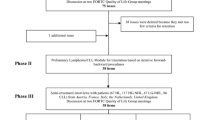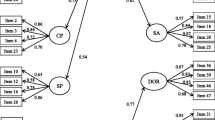Abstract
International cooperative clinical trials require a multilingual quality of life questionnaire. The ‘International Society for Chemo- and Immunotherapy’ therefore designed a study to develop and test a ‘health accentuated’ quality of life questionnaire in the eight languages spoken in this society. The objective was to examine practicability, reliability and interlingual homogeneity. Versions of the questionnaire in Czech, German, Hungarian, Italian, Kroatian, Polish, Romanian and Slovakian have been prepared. The results are based on data of 1,104 adult patients. They demonstrate that the developed questionnaire is practicable. Patients need 10–15 min to answer it, usually without assistance. The proportion of missing values is for all but two questions less than 3%. The questionnaire also found high acceptance reflected by only 2.7% refusals. It is reasonably reliable in each language. Interlingual homogeneity could be shown by demonstration of strong structural similarities between the different versions using multidimensional scaling, factor analysis and comparison of mean profiles.
Similar content being viewed by others
References
Aaronson NK, Meyerowitz BE, Bard M, et al. Quality of life research in oncology. Past achievements and future priorities. Cancer 1991; 67: 839–843.
Donovan K, Sanson-Fisher RW, Redman S. Measuring quality of life in cancer patients. J Clin Oncol 1989; 7: 959–968.
Monipour CM, Feigl P, Metch B, et al. Quality of life end points in cancer clinical trials: review and recommendations. J Natl Cancer Inst 1989; 81: 485–495.
Bullinger M. Erhebungsmethoden. In: Tüchler H, Lutz D, eds. Lebensqualität und Krankheit. Köln: Deutsche Ärzte-Verlag, 1991: 146–152.
Hofmann S. Vorbereitende Schwerpunktsetzung. In: Tüchler H, Lutz D, eds. Lebensqualität und Krankheit, Köln: Deutsche Ärzte-Verlag, 1991: 50–62.
Kelly G. The Psychology of Personal Constructs. New York: WW Norton, 1955.
Cella DF, Tulsky DS. Measuring quality of life today: methodological aspects. Oncology 1990; 4: 29–38.
Aaronson NK, Bullinger M, Ahmedzai S. A modular approach to quality-of-life assessment in cancer clinical trials. Recent Results in Cancer Research 1988; 111: 231–249.
Schulz W, Költringer R, Norden G et al. Lebensqualität in Österreich. Wien: Eigenverlag, 1985.
Fischer G. Einführung in die Theorie psychologischer Tests. Bern: Hans Huber, 1974.
Kubinger KD. Gütekriterien zur Beurteilung von Fragebögen. In: Tüchler H, Lutz D, eds. Lebensqualität und Krankheit. Köln: Deutsche Ärzte-Verlag, 1991: 146–152.
Hofmann S, Tüchler H, Bernhart M, et al. A practicable questionnaire for quality of health and quality of life assessment in patients with haematooncological disease: psychometric properties (German). Onkologie 1992; in press.
Dijkstra W, van derZouwen J. Response behaviour in the survey-interview. London: Academic Press, 1982.
Cronbach LJ. The coefficient alpha and the internal structure of tests. Psychometrica. 1951; 16: 297–302.
Lord FM, Novick MR eds. Statistical Theories of Mental Test Scores. Reading, MA: Addison-Wesley, 1968.
Carroll JD, Chang JJ. Analysis of individual differences in multidimensional scaling via an N-way generalization of Eckart-Young decomposition. Psychometrika 1970; 35: 283–319.
Pruzansky S. SINDSCALE-Individual differences in MDS (computer program). Bell telephone Laboratories, Murray Hill, New Jersey, 1975.
Claus G, Ebner H. Grundlagen der Statistik. Berlin: Volkseigener Verlag, 1974.
Meredith W. Rotation to achieve factorial invariance. Psychometrika 1964; 29: 887–206.
Tucker LR. Maximum validity of a test with equivalent items. Psychometrika 1946; 11: 1–13.
Bauer WD. OROFAM version 1.2 (computer program). Consent Marketing Research, Vienna 1991.
Likert R. A technique for the measurement of attitudes. Archives of Psychology 1932; 140: 1–55.
Bortz J., Lehrbuch der empirischen Forschung. Heidelberg: Springer, 1984.
Gittler G. Inhaltliche Aspekte bei der Itemselektion nach dem Modell von Rasch. Zeitschrift für experimentelle und angewandte Psychologie 1986; 33: 386–412.
Mokken RJ, A Theory and Procedure of Scale Analysis. The Hague: Mouton, 1971.
Aaronson NK. Methodological issues in assessing the quality of life of cancer patients. Cancer 1991; 67: 844–850.
Blalock HM, Conceptualization and Measurement in the Social Sciences. London: Sage Publications, 1982.
Author information
Authors and Affiliations
Rights and permissions
About this article
Cite this article
Tüchler, H., Hofmann, S., Bernhart, M. et al. A short multilingual quality of life questionnaire — practicability, reliability and interlingual homogeneity. Qual Life Res 1, 107–117 (1992). https://doi.org/10.1007/BF00439718
Received:
Issue Date:
DOI: https://doi.org/10.1007/BF00439718




